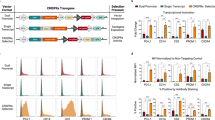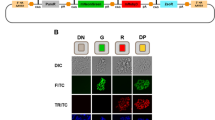Abstract
Tet-on cell lines engineered to stably express doxycycline (Dox)-regulated reverse transcriptional transactivator (rtTA) have many applications in biomedical research and biotechnology. Unfortunately, construction and maintenance of such cells often proves to be costly, labor intensive and ineffective. Moreover, the Tet-on clones generated using standard methodology were often unstable and frequently displayed significantly changed physiological properties compared with their parental cells. Here we describe an optimized protocol for generation of Tet-on cells. The protocol is based on the use of a recently developed pN1pβactin-rtTA2S-M2-IRES-EGFP vector (where IRES is an internal ribosome entry site) and permits relatively inexpensive construction of many Tet-on clones with essentially 100% efficiency. The method is well suited for 'difficult' cell lines displaying genetic instability and high levels of epigenetic silencing. The constructed Tet-on cells remain stable with time in the absence of any selection agents, are easy to monitor and preserve the characteristics of parental cells. The protocol can be completed in 2 months.
This is a preview of subscription content, access via your institution
Access options
Subscribe to this journal
Receive 12 print issues and online access
$259.00 per year
only $21.58 per issue
Buy this article
- Purchase on Springer Link
- Instant access to full article PDF
Prices may be subject to local taxes which are calculated during checkout




Similar content being viewed by others
References
Fussenegger, M. The impact of mammalian gene regulation concepts on functional genomic research, metabolic engineering, and advanced gene therapies. Biotechnol. Prog. 17, 1–51 (2001).
Kaufmann, H. & Fussenegger, M. Metabolic engineering of mammalian cells for higher protein yieldin. Gene Transfer and Expression in Mammalian Cells (ed. Makrides, S.C.) 457–569 (Elsevier Science, Amsterdam, 2003).
Toniatti, C., Bujard, H., Cortese, R. & Ciliberto, G. Gene therapy progress and prospects: transcription regulatory systems. Gene Ther. 11, 649–657 (2004).
Berens, C. & Hillen, W. Gene regulation by tetracyclines. Constraints of resistance regulation in bacteria shape TetR for application in eukaryotes. Eur. J. Biochem. 270, 3109–3121 (2003).
Gossen, M. et al. Transcriptional activation by tetracyclines in mammalian cells. Science 268, 1766–1769 (1995).
Corbel, S.Y. & Rossi, F.M. Latest developments and in vivo use of the Tet system: ex vivo and in vivo delivery of tetracycline-regulated genes. Curr. Opin. Biotechnol. 13, 448–452 (2002).
Zhu, Z., Zheng, T., Lee, C.G., Homer, R.J. & Elias, J.A. Tetracycline-controlled transcriptional regulation systems: advances and application in transgenic animal modeling. Semin. Cell Dev. Biol. 13, 121–128 (2002).
Baron, U. & Bujard, H. Tet repressor-based system for regulated gene expression in eukaryotic cells: principles and advances. Methods Enzymol. 327, 401–421 (2000).
Urlinger, S. et al. Exploring the sequence space for tetracycline-dependent transcriptional activators: novel mutations yield expanded range and sensitivity. Proc. Natl. Acad. Sci. USA 97, 7963–7968 (2000).
Hofmann, A., Nolan, G.P. & Blau, H.M. Rapid retroviral delivery of tetracycline-inducible genes in a single autoregulatory cassette. Proc. Natl. Acad. Sci. USA 93, 5185–5190 (1996).
Chtarto, A. et al. Tetracycline-inducible transgene expression mediated by a single AAV vector. Gene Ther. 10, 84–94 (2003).
Szulc, J., Wiznerowicz, M., Sauvain, M.O., Trono, D. & Aebischer, P. A versatile tool for conditional gene expression and knockdown. Nat. Methods 3, 109–116 (2006).
Gopalkrishnan, R.V., Christiansen, K.A., Goldstein, N.I., DePinho, R.A. & Fisher, P.B. Use of the human EF-1α promoter for expression can significantly increase success in establishing stable cell lines with consistent expression: a study using the tetracycline-inducible system in human cancer cells. Nucleic Acids Res. 27, 4775–4782 (1999).
Munoz, I., Gomez, A., Zanuy, S. & Carrillo, M. A one-step approach to obtain cell clones expressing tetracycline-responsive transactivators. Anal. Biochem. 331, 153–160 (2004).
Whitelaw, E. et al. Epigenetic effects on transgene expression. Methods Mol. Biol. 158, 351–368 (2001).
Welman, A. et al. Construction and characterization of multiple human colon cancer cell lines for inducibly regulated gene expression. J. Cell. Biochem. 94, 1148–1162 (2005).
Qu, Z. et al. Homogeneity and long-term stability of tetracycline-regulated gene expression with low basal activity by using the rtTA2S-M2 transactivator and insulator-flanked reporter vectors. Gene 327, 61–73 (2004).
Mizuguchi, H., Xu, Z.L., Sakurai, F., Mayumi, T. & Hayakawa, T. Tight positive regulation of transgene expression by a single adenovirus vector containing the rtTA and tTS expression cassettes in separate genome regions. Hum. Gene Ther. 14, 1265–1277 (2003).
Author information
Authors and Affiliations
Corresponding author
Ethics declarations
Competing interests
The authors declare no competing financial interests.
Rights and permissions
About this article
Cite this article
Welman, A., Barraclough, J. & Dive, C. Generation of cells expressing improved doxycycline-regulated reverse transcriptional transactivator rtTA2S-M2. Nat Protoc 1, 803–811 (2006). https://doi.org/10.1038/nprot.2006.117
Published:
Issue Date:
DOI: https://doi.org/10.1038/nprot.2006.117
This article is cited by
-
Characterization of changes in global gene expression in the hearts and kidneys of transgenic mice overexpressing human angiotensin-converting enzyme 2
Laboratory Animal Research (2020)
-
A caspase-3 ‘death-switch’ in colorectal cancer cells for induced and synchronous tumor apoptosis in vitro and in vivo facilitates the development of minimally invasive cell death biomarkers
Cell Death & Disease (2013)
-
Sustained tumour eradication after induced caspase-3 activation and synchronous tumour apoptosis requires an intact host immune response
Cell Death & Differentiation (2013)
-
Nodular fasciitis: a novel model of transient neoplasia induced by MYH9-USP6 gene fusion
Laboratory Investigation (2011)
-
Development of a tightly-regulated tetracycline-dependent transcriptional activator and repressor co-expression system for the strong induction of transgene expression
Cytotechnology (2011)
Comments
By submitting a comment you agree to abide by our Terms and Community Guidelines. If you find something abusive or that does not comply with our terms or guidelines please flag it as inappropriate.



